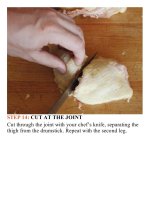The food lab better home cooking through science ( PDFDrive ) 80
Bạn đang xem bản rút gọn của tài liệu. Xem và tải ngay bản đầy đủ của tài liệu tại đây (134.02 KB, 2 trang )
possible that even with your temperature dial adjusted to
thecorrectposition,yourfridgemightbefarwarmerthan
itshouldbe.Asimpledialthermometerhelpsyoumonitor
thingstoensurethatyou’renevercaughtinthedark.
• Transfer food to smaller containers . I keep a stack of
half-pint, pint, and quart plastic deli containers to store
almost all food once it’s come out of the original
packaging. Air is the enemy of most foods and can
increase their rate of spoilage. By transferring them to
smallercontainers,younotonlyminimizeaircontact,but
you also help keep your fridge organized and easy to
navigate.
• Label everything. As soon as you transfer food into a
smaller storage container, label the container, using
permanent marker on masking tape with the date of
storage, as well as what’s inside.As much as I promote
good science, there are some things that simply aren’t
worth experimenting with: creating life inside your
refrigeratorisoneofthem.
•Preventdrippage.Toavoidmessesanddangerouscrosscontamination, always store raw meat—no matter how
wellwrapped—onaplateoratraytocatchanydrips.
• Keep fish extra cold. It’s best to use fresh fish
immediately,butifyoumuststoreit,wrapitinplasticand
sandwichitbetweentwoicepacksonatraytoensurethat
itstaysat32°Forcolderuntilreadytouse.(Don’tworry
—becauseofdissolvedsolidsinitscellstructure,itwon’t
freezeuntilwellbelow32°F.)
WheretoStoreFoodintheRefrigerator
Therearethreeoverridingfactorstoconsiderwhendeciding
whattostorewhereinthefridge.
• Foodsafety is of utmost importance. Fridges keep food
fresh for longer, but that doesn’t mean that harmful
bacteria can’t multiply to dangerous levels given enough
time.To minimize risk, here’s a rule of thumb: the more
likely the possibility a food could make you sick and the
higher the final temperature you intend to cook it to, the
lowerintherefrigeratoritshouldbestored,bothtokeepit
cooler and to prevent cross-contamination. For instance,
don’t store raw chicken above leftovers from the night
before. Juices from the bird can drip down unnoticed,
contaminatingyourfood.
•Temperaturevariesthroughoutyourrefrigerator,with,as
mentionedearlier,eithertheverybackofthebottomshelf
or the back of the top shelf, near the vent, being the
coldest spot, depending on the model. For maximum
storage life, your refrigerator should be set to hold a
minimum temperature of 34°F in these spots. No part of
yourrefrigeratorshouldriseabove39°F.
•Humidityplaysaroleinthefreshnessofvegetables.The
crisper drawers in the bottom of your refrigerator are
designed to prevent fresh cold air from circulating into
them.Vegetablesnaturallyemitabitofenergyastheygo
abouttheirnormalenergycycles,heatingupthespacein
thedrawer,thusenablingittoretainmoremoisture.Moist
air can help prevent vegetables from shriveling or drying
out. Most crisper drawers have a slider that controls the
ventilationsothatyoucanadjustthemoisturelevelinside









